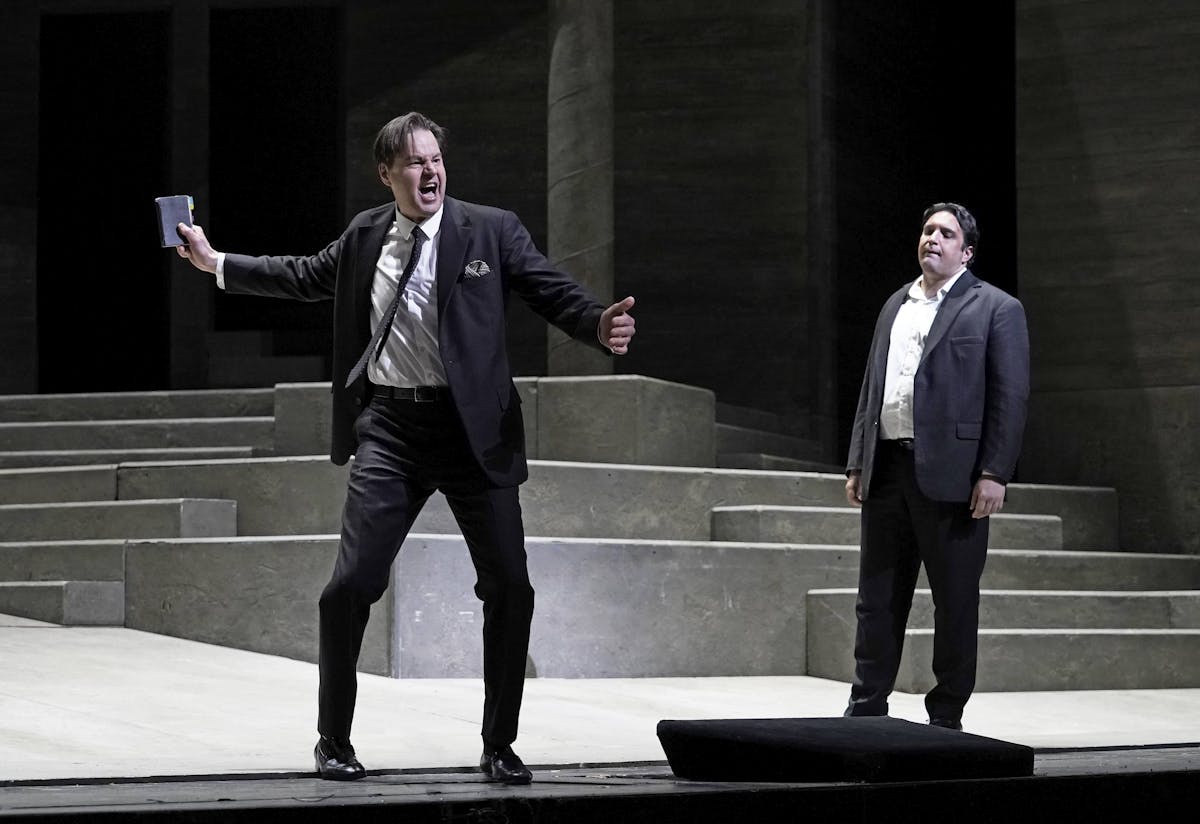Eternal Damnation à la Mode
The Met’s new production of Mozart’s perennial ‘Don Giovanni’ presumably aims to draw parallels between the mythical sex-offending Don and our own epoch, yet has a side effect of highlighting this very contrast.

Smoke billows in a narrow sliver of light. Everywhere else is darkness — an effective use of chiaroscuro. The orchestra sounds a powerfully ominous D minor cloud. Before he even enters the stage we get the feeling that things won’t go very well for Don Giovanni.
The Met’s new production of Mozart’s perennial, which debuted on May 5 and runs through June 2, is directed by Ivo van Hove, who seized upon the opera’s original title, “The Rake Punished,” as a key to the darkness of his modern staging.
The Tony-winning Belgian director, in his Met debut, works with his longtime set and lighting collaborator Jan Versweyveld to create stark environments intended to bring this age-old cautionary tale of a licentious libertine into the present tense. The production is a model of restraint and focussed intensity, using dramatic lighting and muted color to potent effect.
Onstage, three buildings loom large. They recall Brutalist architecture as well as the odd perspective and scale of Giotto paintings. Much of the original context and setting is dispensed in favor of claustrophobic gray mood-scapes. There is not a lot of room for the singers to move.
Occasionally, as in the gorgeously rendered “Deh, vieni alla finestra,” characters occupy rooms in the floors up above. It wasn’t until late in the second act that I realized that the sets had changed at all, so subtle was their motion. This provided a pleasurable “ah-ha” moment. The drab structures can feel oppressive at times, but there is a big payoff in the end.
Throughout the performance, the music hummed and soared, driven with ease and elan under the baton of French conductor Nathalie Stutzmann, who also makes her Met debut. Mozart’s kaleidoscopic musical vision, heartbreaking one moment and silly the next, is brought to life with a feeling of effortlessness.
Ms. Stutzmann, who is also a renowned contralto singer, coaxes a feeling of comfort and grace out of the vocalists, sustaining the energy without pushing too hard. Each sound and voice is in conversation, supporting one another, given space to be heard.
Arias segue into recitative sections seamlessly, creating a feeling of continuous musicality that extends to even the comic bits. Ms. Stutzmann opts for the period instrumentation of fortepiano, cello, and theorbo during the continuo segments, adding a historic authenticity that is compellingly offset by the modern visuals.
Swedish baritone Peter Mattei has been singing the title role for over 20 years and has made it a cornerstone of his repertoire. This is evident in his confidence and mastery of the music. But the blocking doesn’t always know what to do with his body, resulting in a lack of overall menace.
His singing was at its most sublime in the duo “La ci darem la mano,” in which he seduces Zerlina. Soprano Ying Fang, who plays her, sparkles. At times the music almost seems to make her levitate. Her charm, body language, and facial expressions bring complexity and playfulness to the role, while her vocals project beyond the character’s girlish veneer.
Survivor Donna Anna, sung by Federica Lombardi, is a study of silken rage and grief, and has a rounder, fuller sound than Ms. Fang. Another of the Don’s victims, Donna Elvira, looking as though she stepped out of an Edward Hopper painting, is sung by Ana María Martínez, who brings a suitable amount of exasperation to the role. Her “I love him, I love him not” aria, “Mi tradi,” was an Act II highlight.
Ben Bliss’s Don Ottavio provided a welcome respite from the lower register of the rest of the male cast, his elegant tenor potently cutting through the mix with no trace of straining and receiving a thunderous applause. While the Commendatore, sung by Alexander Tsymbalyuk, boomed a powerful bass, he was belied by awkward direction, especially during the crucial condemnation aria, “Don Giovanni, a cenar teco m’invitasti.” If it was seen as too hokey to have a talking statue, this wasn’t an improvement.
Mozart’s opera, which has gone through a string of coolly received Met productions in the past few decades, is regarded as one of the greatest in the repertoire, yet also one of the most difficult to stage. Part of this comes down to the text itself, written by Lorenzo Da Ponte. Dubbed in Mozart’s score as a buffa, or comic opera, the themes and arias are often anything but funny. Yet the recitative sections function to create comic relief.
The new production, which presumably aims to draw parallels between the mythical sex-offending Don and those of our own epoch, has a side effect of highlighting this very contrast. If the modern setting makes the subject of abuse more real and less abstract, what are we to make of all the jokes about it?
Adam Plachetka, in the role of Giovanni’s disgruntled, yet affable, sidekick Leporello turns in a stirring rendition of the classic, buoyant “Catalogue” aria, in which Giovanni’s thousands of conquests (victims) are listed as though they were an inventory of luxury goods. As it has been for centuries, the piece is played for laughs. But the laughter in the audience is now somewhat muted. Why is this supposed to be funny?
This being the 578th Met performance of the work, it’s hardly a spoiler to reveal that Don Giovanni is ultimately sentenced to eternal damnation. We knew it from the first note, really. But the new staging of the famous finale is harrowing, employing projections and smoke to startling effect without the use of trap doors or other theatrical conventions.
There’s no falling into hell — it’s been around us the whole time, becoming more and more explicit as the visuals zoom in. The climactic scene breathes new life into a 235 year old opera, and isn’t that the goal of any re-staging?

